HP-1121A 500 MHz AC Probe
Activity: 1) Check functionality of the probe, and if it works, 2) Put together needed plus/minus voltage supply to power the probe, 3) Identify DC blocks for output of probe.
From the manual:
- The HP-1121A 500 MHz AC Probe is a 1:1 active voltage probe that provides low input capacitance, high input impedance, high current gain and wide bandwith.
- The probe has a probe-tip impedance of 100 KOhms shunted by less than 3 pF. When used with the 10241A or 10243A voltage dividers the input shunt capacitance is less than 1 pF.
- The probe permits testing high frequency circuits without significant loading effects. High imput impedance is maintained by a field effect transistor (FET) circuit.
- The dynamic range of the 1121A is plus/minus 0.5 volt (350 mV rms) without the voltage dividers.
- The probe requires +15V at 110mA max and -12.6V at 70 mA max.
This probe has a BNC-male connector for the RF path and a special 3-pin DC power connection (typically attaches to a special purpose $$$ power supply which I do not have). Used the Agilent 11899A probe power supply manual to determine the proper pinout of the custom 3-pin probe power connector.
Here is the probe connected to HP6234A dual-voltage supply, with approx +15V and approx -12V applied to the power connector. The probe end has a simple 6" telescoping whip attached and the TinySA-Ultra is tuned to a local (very strong) FM station. It works!
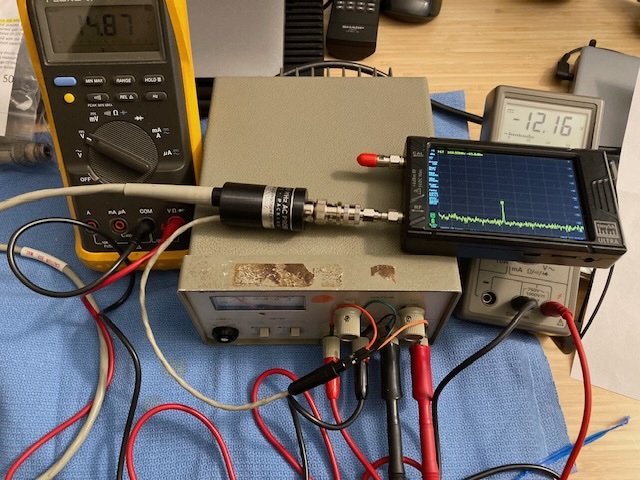
With the probe known to be working, the next step was to put together a low-cost, build from lab stock power supply for it (using non-adjustable wall-wart supplies). Using fixed supplies ensures that a bench supply knob won't get bumped -- accidently frying the AC probe due to overvoltage. Looking through the modular supplies box yielded a +15V 1A DC supply and a 12V 1A DC supply. Cutting off DC plugs and inserting wires into the probe's special power plug (socketed pins), along with some strain relief on the wiring, yielded a working supply and probe combination. Added a 3:1 AC strip to ensure the power supplies come up reasonably at the same time. A little kludgy, but works fine in practice.
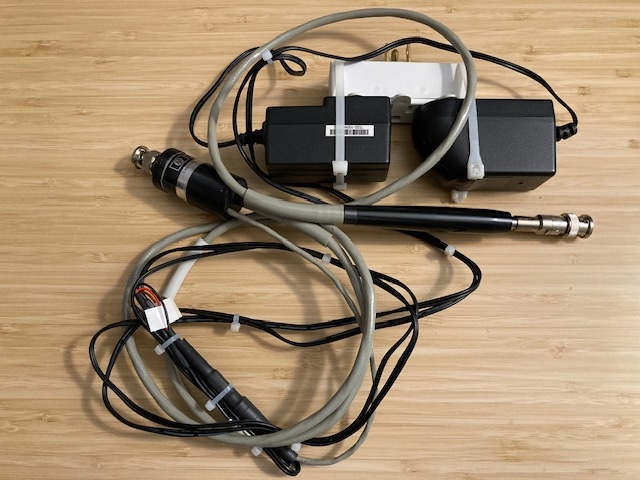
I'll keep an eye out for the special/custom HP probe power supplies at future hamfests, but for now, the 1121A AC probe is working and available for lab use. Project complete!
Found this write up by PA4TIM on his probe (with power supply and extension cables). Nice!
Closing note: Turns out these probes require an AC coupled output. Direct attachment to a 50 Ohm DC-coupled input can damage the probe's circuits. Something to remember and check before-use in the future! (Definitely a problem when used with a scope with the input set to 50 Ohm termination. This is also a problem with TinySA-Ultra spectrum analyzer which does not include a blocking capacitor as part of the input circuit. Will need to evaluate the NanoVNA-H4 to see if it does or does-not include DC blocks as part of the receiver paths.)
Here's my low frequency DC block (up to ~ 1 MHz) using a 2.2uV @50V capacitor. The 1 K ohm resistor is used to discharge any residual voltage off of the electrolytic capacitor before, during, or after use.
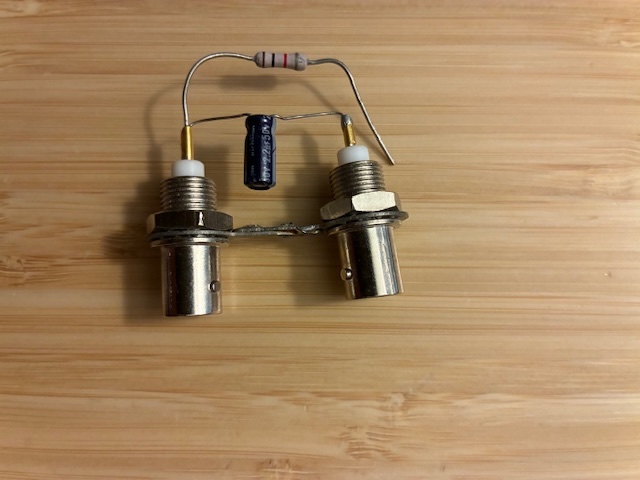
Testing with the NanoVNA-H4 to determine the low frequency response (down to 50 KHz).
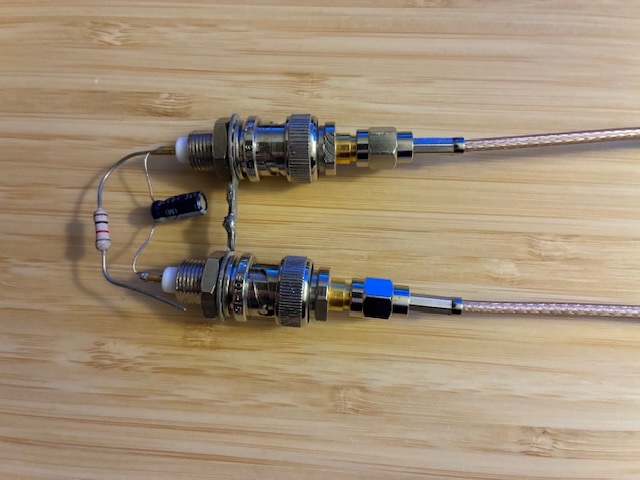
Response shows flat to 50 KHz (as expected).
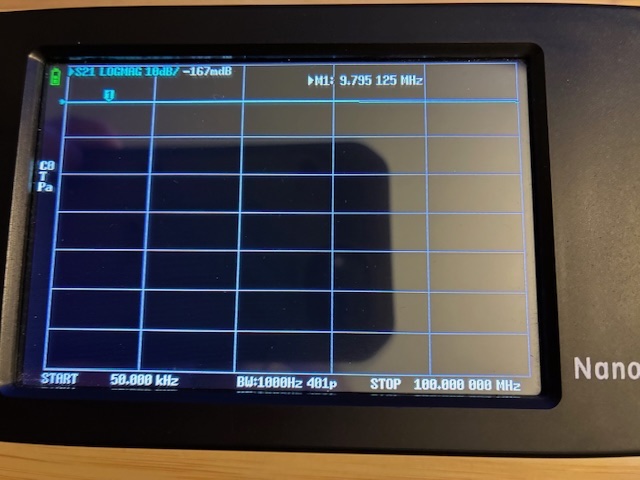
Above 1 MHz, a Mini-Circuits BLK-18-S+ SMA connectorized unit is available to perform the needed AC coupling function on the output of the HP1121A probe. A BNC to SMA adapter is used to connect to the probe's BNC-M output connector.
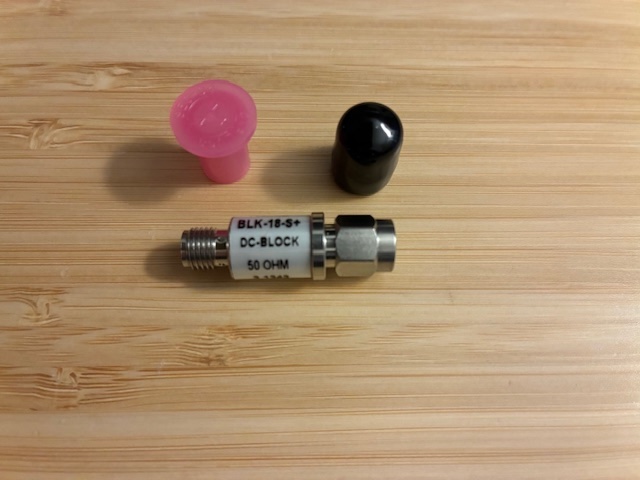
Below is the test setup with the NanoVNA-H4:
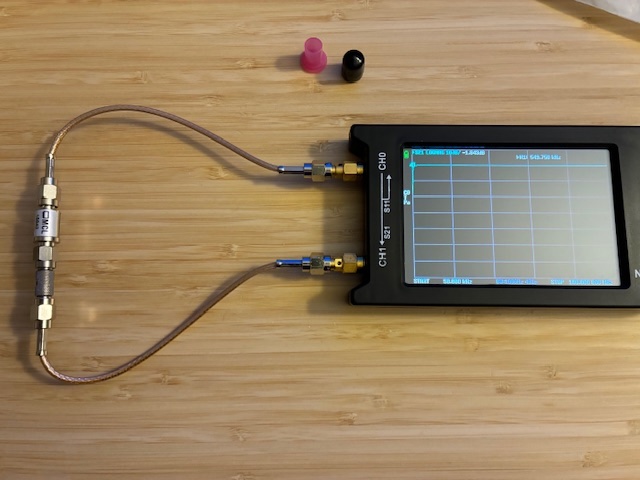
The MCL DC block works very well, with only 1.8 dB loss down at around 540 KHz.

My plan is to use the BNC/capacitor for signals under 1 MHz and the MCL BLK-18-S+ for all frequencies above that. Plus/minus having to use some adapters on the probe output, this appears to be a very workable solution.
Wrapping up this post: The HP1121A probe is known to be working, with a replacement DC supply configured and attached supporting lab bench top use. A set of DC block adapters is on-hand to provide the needed DC isolation at the probe's BNC output connection.
Alternatives: If measuring RF circuits, an Agilent/HP 85024A is a nice capability. Connect it to your network analyzer or RF spectrum analyzer and collect data up to 3 GHz. Nice, but very expensive! (The HP1121A was a "here, want this?" item that supports the majority of the home lab measurements. Will continue looking for an inexpensive HP85024A at local ham fests!)